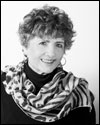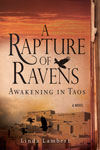« Emergence and… | Leaving Taos…for the moment »
Searching for D.H. Lawrence….
Lawrence died 80 years ago, yet he is very much alive here in Taos. Incredible, isn’t it? It’s important to realize that even though Lawrence was only in Taos three times for a total of 16 months (1922-1925), he considered the Ranch—given to his wife Frieda by Mabel Dodge Luhan in 1923—to be his real home. His letters written from 1926 to 1930, when he died of tuberculosis, brimmed with yearnings to return to the embrace of Taos.
Bill Haller, President of the Friends of the D.H. Lawrence Ranch, is more passionate about Lawrence than anyone I’ve ever met. He has been our frequent host. Most of what we’ve experienced here in reference to Lawrence has been the result of Bill…including the climb to the cave and waterfall (sans water at this time of year) on the Kiowa trail featured in the sacrifice scene at the end of The Woman Who Rode Away.
Art Bachrach is the owner of the bookstore Moby Dickens, founder of the Friends group, author of D.H. Lawrence in Taos, and 30-year resident of this vibrant village. His health is fragile and his eyesight is gone, but his mind is extraordinarily sharp. Today we spent the last couple of hours that we’ll have with him on this trip at his house. He is home now from a couple of months in the hospital and regaled us with little known stories of Lawrence and Taos. He returned to The Rainbow many times during our conversation, telling us that it was the most scandalous of Lawrence’s writings, after which the disappointed author could not get anything published for four years (The Rainbow is the selection for our next Sea Ranch book club).
Santa Fe seems jealous that Lawrence chose Taos and occasionally offers up mini-festivals devoted to the famous author. One set of events occurred just last week: a BBC remake of Women in Love by William Ivory and a play entitled Empty Bed Blues by Stephen Lowe. Both men from Nottingham, England, came to the Ranch here in Taos in the middle of the week and we met them there—at the behest of our gracious host, Bill. Our discussion of Lawrence was fascinating and Morgan and I drove to Santa Fe the next day to see the play.
Bill also introduced us to Professor David Farmer, who was responsible for bringing the Cambridge University version of Women in Love to publication. David’s carefully researched Introduction to the text traces the multitude of letters, struggles with content, agents, and publication; and, he faithfully rectified the text itself, thereby publishing one of the foremost novels of the 20th century in the form originally intended by the author. On Tuesday, we’ll meet again with the Farmers for wine at Lambert’s (a restaurant).
Dr. Tomas Jaehn, the archival director of the New Mexico Historical Museum in Santa Fe, unearthed for me (from behind glass in the museum) a three-page typed essay by Mabel that described Lawrence as the mystic I believe him to be. Yesterday, he sent a postcard from Lawrence mailed in New York in May, 1929. Since Lawrence did not return to the U.S. after 1925, Tomas asked if I thought it was the author’s handwriting. I matched the writing with a copy of the original manuscript of Sons and Lovers (the original now in the possession of UC Berkeley) and said that I thought it was his writing…but sent it on to David Farmer for verification.
Jan Mellor, owner of the Taos Art Gallery, cared for Eya Fechin at the end of her life. Now who is Eya, you may ask? In the mid-20’s, the famous Russian artist Nicolai Fechin came to Taos. Now a major museum occupies his home and studio where his wife Alexandria, and later his daughter Eya, lived out the end of their lives. Eya was central to the dramatic sociogram of interconnected artists that made this community unique. On Wednesday, after the D.H. Lawrence Ranch board meeting (at which I’ll report on my progress here), Jan will give us a historical tour of the Fechin home.
Mabel Dodge Luhan, who started it all by inviting the great minds and talents of the day to Taos (Lawrence, O’Keeffe, Carl Jung, Ansel Adams, Willa Cather, Tennessee William, Nicolai Fechin—to just name a few), is buried near Ralph Myers in the Kit Carson Cemetery. Ralph’s son Ouray explained that her wise husband, Tewa Indian Tony Luhan, suggested that “Ralph would take care of her.” Tony returned to die and be buried on the Pueblo. More about Mabel in future posts.
Across the meadow from Mabel’s home are two cottages that were part of the compound, one the temporary housing of Lawrence and Frieda, the other occupied occasionally by Carl Jung, Tennessee Williams, Ansel Adams. To Kevin Cannon’s–artist, sculptor, musician–great fortunate, a few years ago he was able to purchase both of them. Kevin has respected the property with an almost sacred regard. His home–that of Lawrence–feels as though nothing has changed. Each turn of attention captures an image of light and stucco and wood…oh my, I’m such a romantic! Stop this, Linda. Will I ever regain objectivity about Lawrence?
Roberta Myers, a playwright and performer, is the former wife of Ouray. We have come to know Roberta by attending her sparkling performances of some of the women who made Taos famous, among them, the three women of D.H. Lawrence and the three wives of Kit Carson. This Wednesday, we’ll attend Roberta’s storyteller event again with friend, Mary Gardner.
We will reluctantly leave Taos (this time) on November 23 and spend Thanksgiving in Salida with daughter Laura and family. But the Taos story is just beginning….
Leave a Reply





 Conceptions of leadership have evolved, and Liberating Leadership Capacity captures these new ideas and provides a pathway to create sustainable systems of high leadership capacity. Available April 2016 from
Conceptions of leadership have evolved, and Liberating Leadership Capacity captures these new ideas and provides a pathway to create sustainable systems of high leadership capacity. Available April 2016 from  A sizzling new novel set in Taos, New Mexico. The third in the Justine Trilogy, preceded by the award-winning, The Cairo Codex and The Italian Letters. Buy it at your local independent bookstore,
A sizzling new novel set in Taos, New Mexico. The third in the Justine Trilogy, preceded by the award-winning, The Cairo Codex and The Italian Letters. Buy it at your local independent bookstore, 
